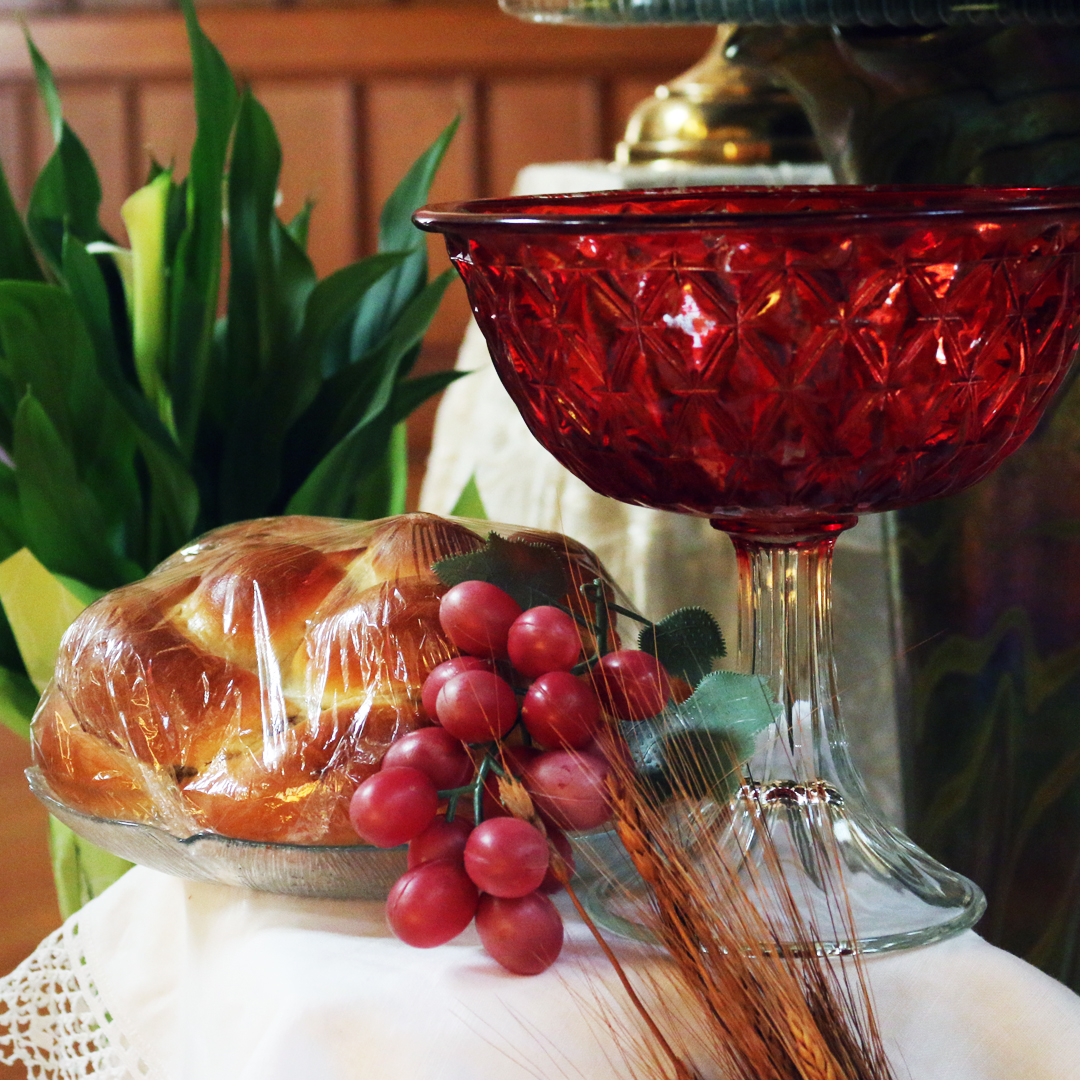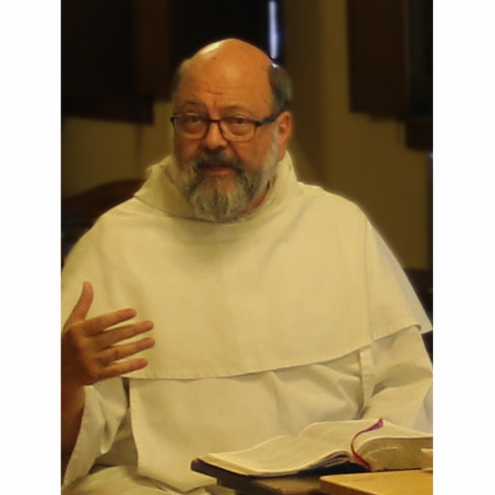Our Lady's Message: Prayer and Penance
During these times, it is good to once again remember what we have been told repeatedly by our Lady when she has appeared in our troubled past – as followers of Christ, we are called to undertake penance and prayer. The specific prayer recommended time and again by Our Lady is the Holy Rosary. But what about penance, the other side of this coin? If all is mercy and we are forgiven, why does God require penance?
Since the Fall of Adam and Eve in the garden of Eden, pain and suffering have been part of every person’s earthly life. Yet there are certain moments in human history that seem darker than the rest, as if all of humanity were racing toward the edge of a cliff. While history will tell whether we are experiencing one of those times now, there is no question that the pain and suffering of our day is, in many ways, unprecedented. During the month of October, it is good to once again remember what we have been told repeatedly by our Lady when she has appeared in our troubled past – as followers of Christ, we are called to undertake penance and prayer.
The specific prayer recommended time and again by Our Lady is the Holy Rosary. We have written before about praying the Rosary, this most beautiful prayer of our Lady that guides us to meditate on the Gospel and leads us to her Son and our Savior Jesus. It is a prayer that changes hearts and lives as it calls down God’s grace and transforms us as it keeps us under the protective mantle of our Blessed Mother. During October, the month devoted to the Holy Rosary, we invite you to join us in renewing a commitment to this prayer.
But what about penance, the other side of this coin? If all is mercy and we are forgiven, why does God require penance?
Most of us approach penance from the wrong direction. We hear “penance” and we immediately equate it with a disagreeable hardship, something we endure for a time, like giving up chocolate Lent, or something we are told to do by the priest in confession. So, we add “penance” to a to-do list and… Check! Done! Now we can move on to something more pleasurable. But that’s not exactly what God meant when He said “take up your cross”, and it’s not how the Church and saints understand penance. As Dom Hubert van Zeller points out in his book, “Approach to Penance”, these may be acts of penance, and are indeed often a good place to start, but true penance goes much deeper than that.
True penance demands a complete surrender of self to the will of God. Penance that is worth anything is not simply a turning from something, but it is a turning to Someone.
Often our acts of penance are inspired by feelings of remorse. We recognize we did something wrong or are overly attached to something (or someone) and we are remorseful. Yet, true penance does not stop at remorse – it must go forward to trust. It is this confusion of remorse and penance that leads to seeing penance as only external acts to be performed instead of a habitual disposition of the soul – a virtue – to be cultivated. Penance as a virtue begins in humility - in acknowledging that God is all and compared to God we are nothing - AND it goes further to have complete confidence and trust in God’s loving mercy.
Why does this matter? Because everyone is called to penance, but not everyone is called to perform the heroic acts of penance we often read about in the lives of the saints. Dom Hubert van Zeller warns us that if we approach penance as only acts to be performed, then we risk falling into one of two errors.
First, we may avoid true penance all together. We say to God, “I’ll give this, but not that”, which means we haven’t really given our whole selves to Him. We can also fall into pride by going down our list of sacrifices and congratulating ourselves at how much we’ve given God. In both cases, the emphasis is on the “I”. It is much better to say, “God, here I am. Take whatever, whenever, however You want.” And then trust that He will give you the grace and strength you will need when He takes you at your word.
The second error we can fall into is to have the desire to deny ourselves, but to be disillusioned because we can’t do as much as the saints, or even perhaps other individuals we know – we aren’t strong enough, or our vocations don’t allow us to perform such heroic acts of penance. Yet penance as a virtue means that the merit of the act is based on the intention of the will. It is the denial of self that is the substance of true penance.
Remember what Jesus said about the poor woman who gave two coins in the collection - she gave more than all the others who came before her because she gave from her poverty; she gave all she had to give. That is all Jesus asks of us - to willingly give all, whether that means two coins or 20 coins doesn’t matter to Him, as long as it is everything.
If we have the desire to give ourselves to God through penance - whether to atone for our own sins or in reparation for the sins of others - it is because God has first instilled in us that desire. This should give us greater faith and hope in Him, because along with the desire, He will give us the grace - Jesus Himself will help us - to complete the gift. Yet we must keep in mind that penance is the way of the cross. It is the way of love, to be sure, but it is also that way of faith and it is a work. In picking up the cross - in developing the virtue of penance - our sole motive should be to please God. We must also realize that we will be called to bear the cross in a shape we didn’t bargain for and that the really effective part is not what we do by way of self-denial but what God does in us by way of reproducing Jesus’ Passion in our everyday lives.
This is why humility and trust is so important - because when Jesus gives us a small part of His cross, or a thorn from His crown, or a share in the wounds He received under the lash, or the humiliation of being despised and ridiculed by others, He is asking us to join Him in His supreme gift of love. We cannot love Jesus completely if we do not also love what He loves, and He loved the cross. Not because he loves pain and suffering itself, but because He loves the Father’s will and He loves us and it is the cross that bridges the way between Him and us.
So how do we put all this into practice? How do we know what specific acts of penance God may be asking us to undertake to cultivate the virtue of penance in our souls?
Only grace will reveal what specifically we are to do, how we are to do it, and when or for how long. God speaks to us in many ways; here are some tips for discerning God’s voice:
Read the Scriptures and the Catechism to learn more about what God and the Church teaches us about prayer and penance.
Find out what the Pope and our bishops are asking us to do (i.e., are they asking the faithful to engage in specific prayers or acts of penance, such as fast days?).
Seek counsel from a wise confessor or spiritual director. This is especially important before taking on more rigorous acts of penance. Remember, God prefers obedience to sacrifice.
Consider your current disposition (i.e., temperament, health, etc.), vocation, and circumstances. God will not call us to take on crosses that are truly beyond our strength or in conflict with fulfilling our vocations (though, admittedly at first, it may feel like it!).
Spend time in prayer and ask God for direction, then listen to what He speaks in your heart. And if you feel a nudge that doesn’t go away, take that seriously. Again, because we are approaching penance as a virtue and total gift of self, our prayer to God is not, “God what more can I give you today?” because, if we have truly given Him everything, we cannot give Him “more”. Rather, our prayer becomes, “God, I’ve given you all of me and with the help of your grace, I renew that gift of self. What would you have me do today?”
Finally, because penance is a virtue to be cultivated, it will take time and practice to grow strong in it. So, when we stumble, remember Jesus also fell under the weight of the cross - offer your weakness to Him with confidence, ask for the help of our Blessed Mother, rise and press forward once more. For the glory of God and the salvation of souls.
Ashes, Dust and Love
Penance. Suffering. Ashes and dust. It’s that time of liturgical year again. So what is the season about? Is it merely to inflict pain and punishment, to make us feel bad about ourselves and our sins? To bring gloom and doom down on us as we are reminded “you are dust, and to dust you shall return”? Certainly if we were a people without faith in a God of mercy and love, without hope for life with Him in heaven, then Lent would indeed be very dark. But we are ultimately an Easter people…
Penance. Suffering. Ashes and dust. It’s that time of liturgical year again. It’s Ash Wednesday. The beginning of Lent. Many of us have a love/hate relationship with this penitential season. We enter into with different levels of commitment. Some of us get pretty creative in our fast and penitential practices to ease into it and slide through. After all, it is innate in us to avoid suffering and seek pleasure. Yet, there is something about the season of Lent that speaks to us on a deeper, more profound level. We NEED it, even if we aren’t sure exactly what to do or how to go about getting the most spiritually out of the season. So, often it stretches before us, six weeks of purple.
So what is the season of Lent about? Is it merely to inflict pain and punishment, to make us feel bad about ourselves and our sins? To bring gloom and doom down on us as we are reminded “you are dust, and to dust you shall return”? Certainly if we were a people without faith in a God of mercy and love, without hope for life with Him in heaven, then Lent would indeed be very dark. But we are ultimately an Easter people, a people of joy and hope and love. Nonetheless, to fully live Easter, we must walk through the passion and death of Christ Jesus, precisely because of sin.
In the creation of Adam and Eve, God made man unique. While we have bodies like the animals, we also have a reason and a will – we are rational creatures. And God gave humans a gift – so long as the mind of man remembered who He was (a creation of God) and remained obedient to Him, then the lower powers of man (his bodily senses and passions) would remain subject to his will and death would be foreign to us. But when Adam and Eve saw the forbidden fruit was good for food, pleasing to the eye, and desirable for wisdom, then took the fruit and ate it, they grabbed at God’s place – they rebelled against the order of creation. Now the carnal appetite of humankind rebels against the spirit and death is the result. Our reason is darkened, our bodies and passions often seek to assert themselves against what we otherwise would will. The forbidden fruit seemed good as food – now we are prone to sins of the flesh (gluttony, lust, sloth). The forbidden fruit was pleasing to the eye – now we are prey to lust of the eyes (greed and envy). And the forbidden fruit was desirable for wisdom – now we puff ourselves up with pride and vainglory and seek to dominate others through wrath.
Fast forward to Jesus. Immediately after Jesus’ baptism, the Holy Spirit drove Him into the desert for forty days and nights – a time of prayer and fasting. It was in the desert that Jesus was tempted by Satan to sin. In His responses to Satan, Jesus shows us how to respond in freedom. Jesus was tempted to turn stones into bread and satisfy His fleshly hunger. He responds, “Man does not live by bread alone.” Jesus was taken to the top of the temple and told to prove He was to Son of God by jumping off – after all, God promised to catch Him (Satan even quotes Scripture in this temptation). But this was a temptation to pride. Jesus answers with humility – “you shall not put the Lord, your God, to the test.” Finally, Jesus was led to a mountaintop and shown the world – it would all be His, if He would just do homage to Satan – a temptation to grab power and possessions, so pleasing to the eye. But at what cost? Jesus says, “Get away, Satan! It is written: The Lord, your God, shall you worship and Him alone shall you serve.”
In the practice of prayer, we are reminded that God is “He who is” and we are those who are not. That is to say, as we grow in relationship with God through prayer, we come to see more clearly the truth about God and ourselves. We grow in humility, charity, and all the virtues as He pours His grace out upon us. But we have to open ourselves up to Him and we do this through prayer.
Through the practice of fasting, penance and mortifications, we bring the body and passions back into subjection to our reason and will. Like a spoiled child that has to be disciplined and trained, our senses, carnal desires and passions need to be purified and brought back into right order. Of course, we can only do this with God’s grace. We are also reminded how weak and helpless we are apart from God. We cannot rely on our own strength – though we work and strive as if it all depends on us, we pray for God’s help and abandon ourselves to Him as if it all depends on Him.
Finally, though almsgiving, that is, the corporal and spiritual works of mercy, we become detached from the things of this world and freed from the sins of greed and envy. We stop worrying about what tomorrow will bring because we learn to trust God’s providence, while at the same time growing in charity toward our neighbors.
Lent is not about punishing ourselves. It is not God’s intent that we simply suffer, as if that were the goal in itself. In St. Catherine’s Dialogue, she repeatedly records God telling her that suffering is NOT a proper goal. Prayer, penitential acts and works of mercy are only worth anything at all because they spring from, are rooted in, and lead to love. So if our Lenten practices are not leading us deeper in relationship with God, helping us do good and avoid sin – in a nutshell, aiding us to more perfectly keep the commands to love God and neighbor – then we need to go back, reassess and adjust our practices.
So, how do your practices of prayer, penance and almsgiving help you love God and neighbor? How can we grow in holiness this Lent? How can we better prepare ourselves to welcome Jesus, like a bride greeting her beloved, on Easter morning?
Beautiful Preaching: Fra Angelico, the Arts and Iconography
Fra Angelico was an examplar Dominican preacher - he sought the face of God in contemplation, gave Christ his entire being and became an instrument in His hand to preach the Gospel and draw people to Himself through the beauty of his paintings and frescoes. This too is the way for the nuns of the Order of Preachers. Our community has, from its beginning, had a tradition in the visual and musical arts, which has blossomed through the course of time in various ways: producing vestments and ecclesiastical linens, Gothic calligraphy and illuminating manuscripts, fine artwork, photography and digital design, and most recently iconography.
To preach the Gospel, words are not always necessary. Today we remember a Dominican friar who remains one of the most renowned artists of all times: Blessed John of Fiesole, more popularly known as Fra Angelico. Fra Angelico was known to frequently say, “If you seek to do the work of Christ, you must live with Christ.” Fra Angelico was an examplar Dominican preacher - he sought the face of God in contemplation, gave Christ his entire being and became an instrument in His hand to preach the Gospel and draw people to Himself through the beauty of his paintings and frescoes.
This too is the way for the nuns of the Order of Preachers. And as each individual is given charisms for the building up of the Church, it is not uncommon to find monastic communities have general charisms as well, both for preaching some particular aspect of the Gospel and often to help support the community: some communities excel in gardening and the use of natural resources, some in various crafts and the production of goods, and so on. Our community has, from its beginning, had a tradition in the visual and musical arts, which has blossomed through the course of time in various ways: producing vestments and ecclesiastical linens, Gothic calligraphy and illuminating manuscripts, fine artwork, photography and digital design, and most recently iconography.
Last fall, our community had an extraordinary opportunity to begin learning an ancient form of prayer and preaching: iconography. Several of our younger sisters have had a desire to learn more about iconography (writing icons) and iconology (the study of icons) and, through the workings of Divine Providence and the generous support of benefactors, several sisters in our community spent a week in an intensive icon retreat with iconographer Kristina Sadley of Prophecy Designs Icons and an affiliate instructor for the Prosopon School of Iconology.
“Icon” is Greek for “image” and traditional icon writing is a prayerful discipline of hand, heart, and mind to bring forth the “Gospel in color” – every canonically written icon reveals Christ, and comes from within the iconographer and his/her prayer.
The week began with Mass, confession, and a blessing of our icon boards and our sister iconographers. Once in our “iconography studio”, we began each morning with prayer, giving glory to the Holy Trinity, asking for grace and illumination as we worked and interceding for those who would venerate the icons we were writing. Except for instructions, our time was largely spent in silence.
We quickly learned that everything in iconography has meaning and purpose – every feature, every color, every step in the process. For example, the wood of the board – a symbol of the wood of the cross; the whiteness of the board – purity and light. Our first step was to trace the image of our icon onto the board using carbon paper, then, once traced, we etched into the white gesso layers with a stylus so our lines would not be lost as we began to apply clay, gold and pigments. This parallels our own life when we receive the Gospel – lightly at first, but when we cooperate with God’s grace, He etches His Word into our hearts.
The next step was also profoundly meaningful to many of us – applying the clay bole and the goldleaf for the icon’s halo. The clay bole represents our humanity. The gold represents God’s glory and divinity. To have the gold adhere properly to the clay, the iconographer must get very close to the clay, with goldleaf piece ready in hand, and breathe deeply but gently on the clay to warm it, reminding the iconographer that God breathed life into Adam. After two or three breaths, the gold is quickly applied and pressed gently onto the warmed clay, and the iconographer moves to the next small section of the halo to begin again. Once the gold is applied, the first color is applied to the board – a bright red line is added to encircle the halo – the blood of Christ and the white has now been broken open into color.
So by now you may be asking, “which icons did the sisters write?” Mary? Jesus? A festal scene? You may be surprised (as we were) to learn we had no choice about our first icon – we would all be writing Saint Michael. But then, Kristina explained why: iconography, as prayer, is a battle – it is spiritual warfare in a profound way. And so we begin with Saint Michael, who is prince of heaven and our help in spiritual battles against the devil. Saint Michael reminds us, “who is like God?” He helps us keep right perspective in humility and our eyes Christ. It is also for these reasons that an iconographer does not part with his or her first icon.
Our first icon completed, our new iconographers are making plans to begin writing their second icon, Saint Gabriel. As Saint Michael helps us grow in humility and clear out the sins and blocks in our hearts and lives to God’s grace, Saint Gabriel brings the Good News and helps us fill our souls with God’s goodness, truth, and beauty.
We give thanks to Kristina and our benefactors whose generosity opened the door for us to this ancient method of prayer and visual preaching of the Gospel. May Fra Angelico intercede for all artists and those who use visual means to promote the goodness, truth and beauty of the Gospel. Saint Michael, Saint Gabriel and Fra Angelico, pray for us!
Want to learn more about assisting our arts and iconography studio or other opportunities to support our cloistered Dominican life? Email us or visit our website. Thank you and God bless!
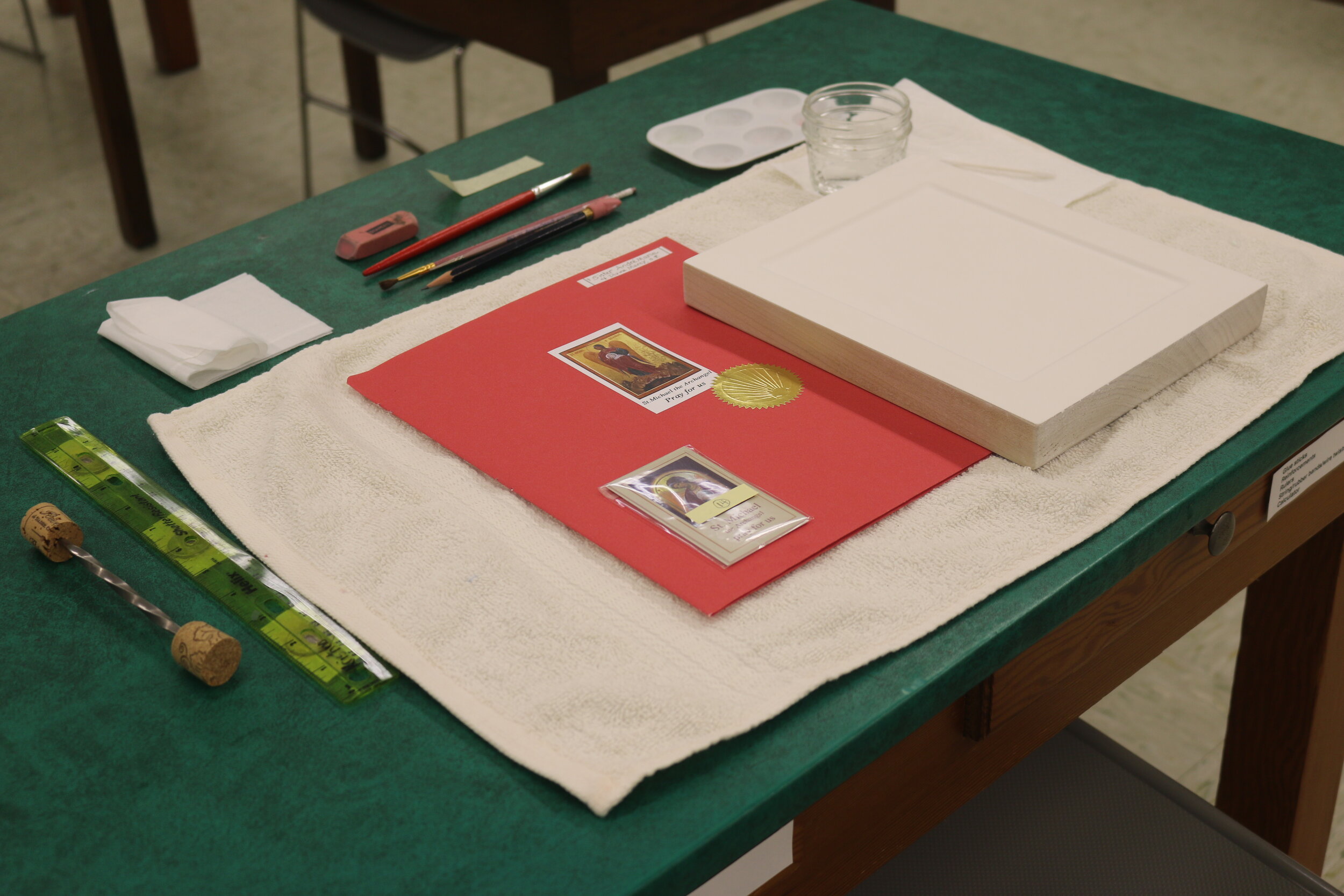
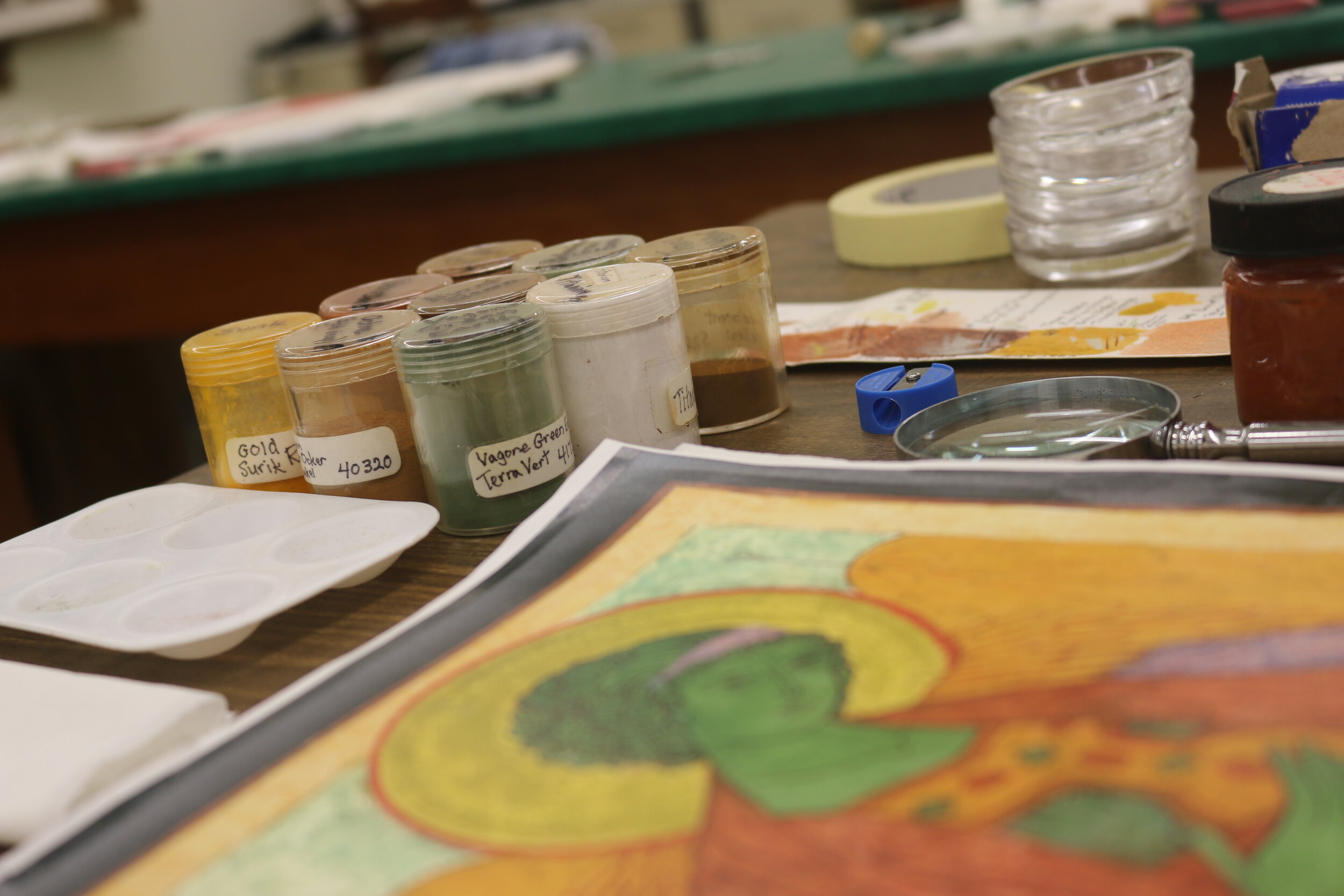
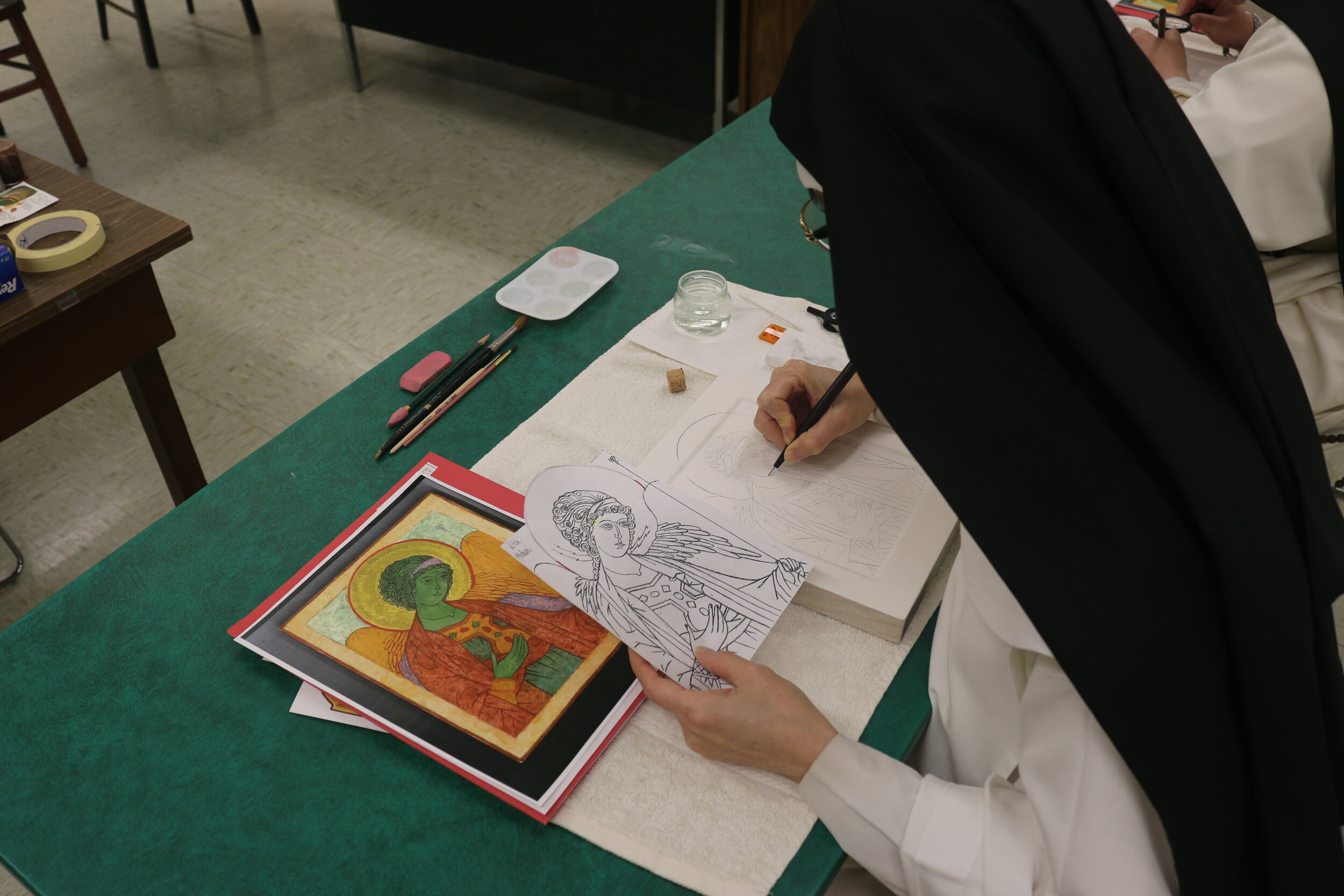
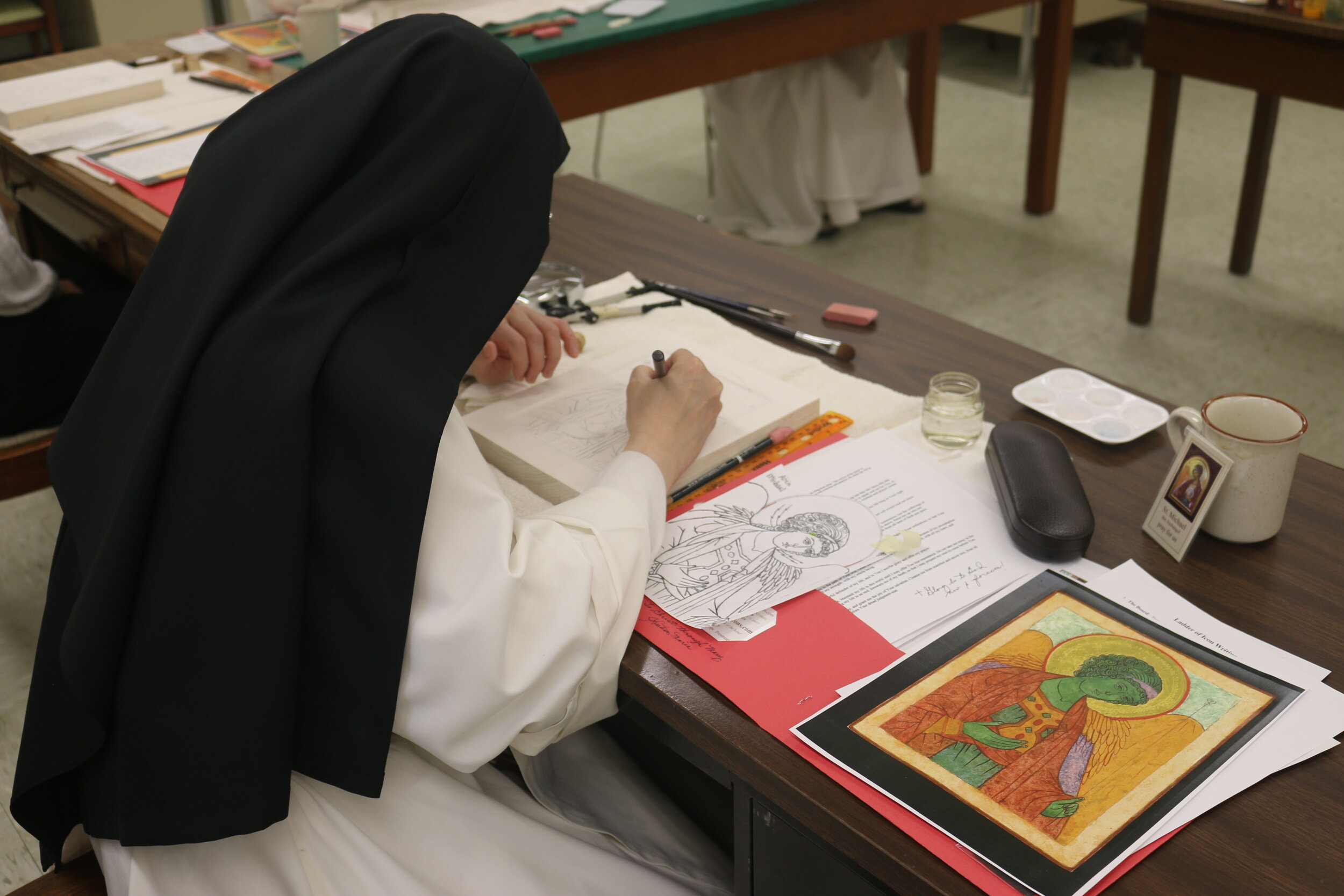
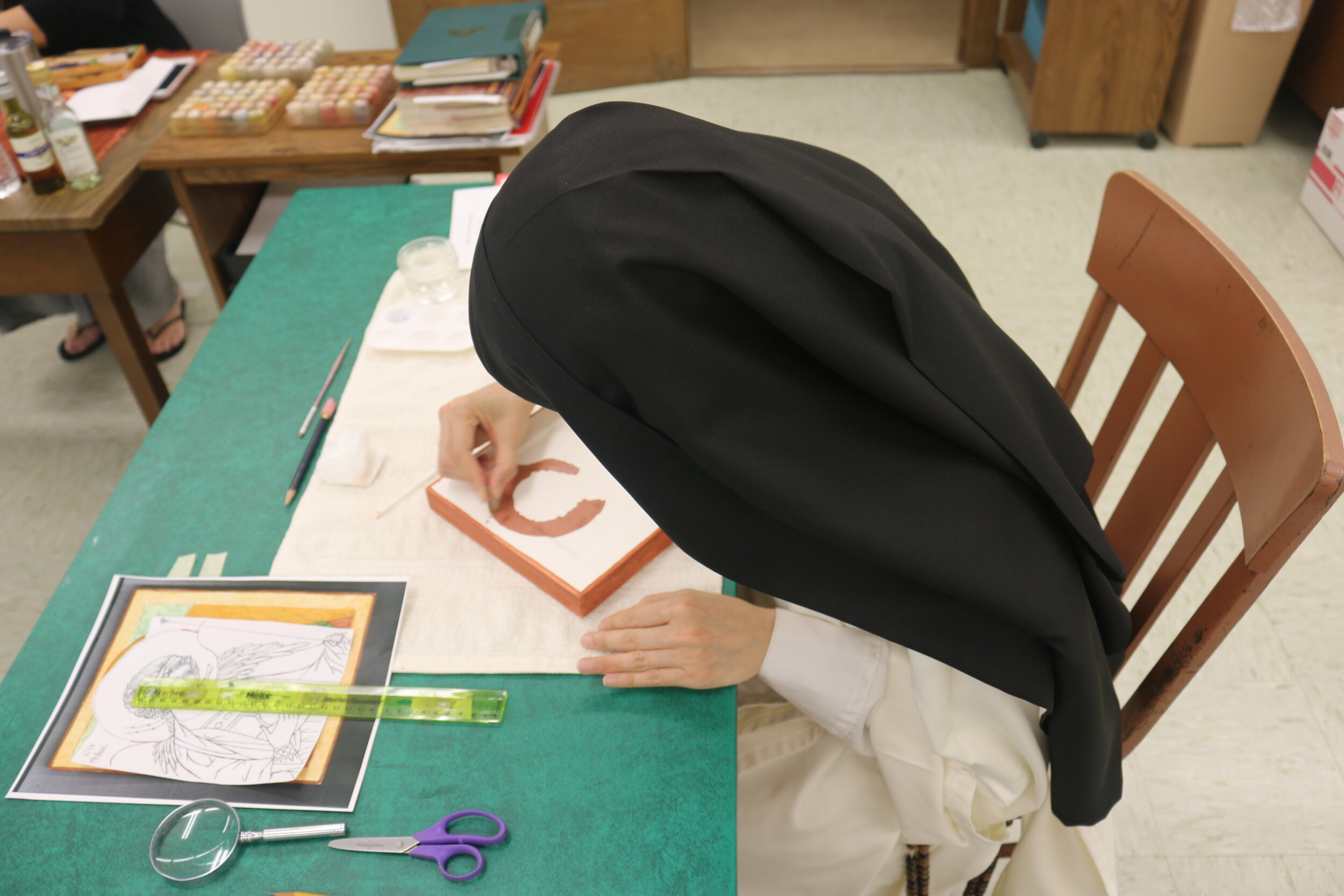
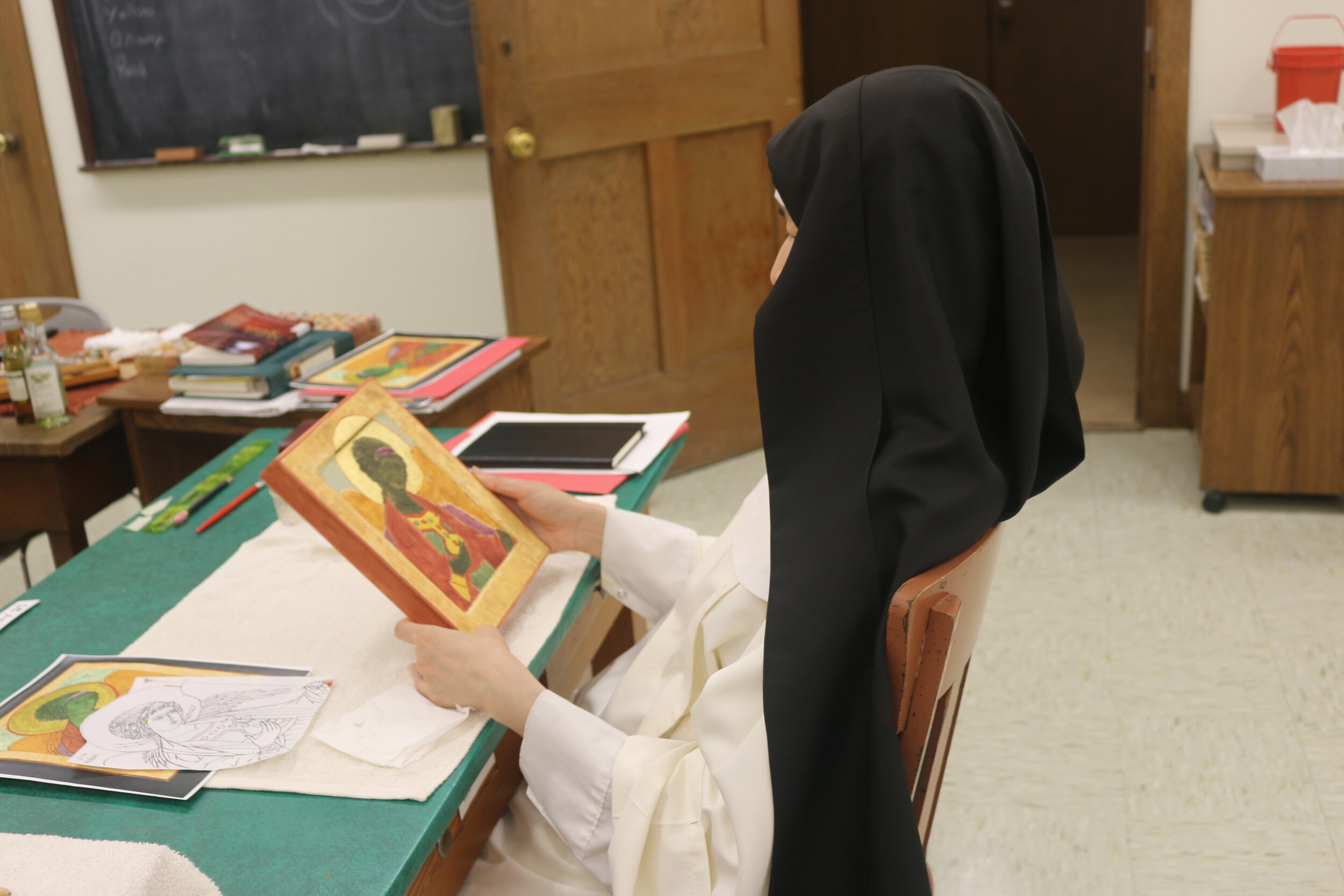

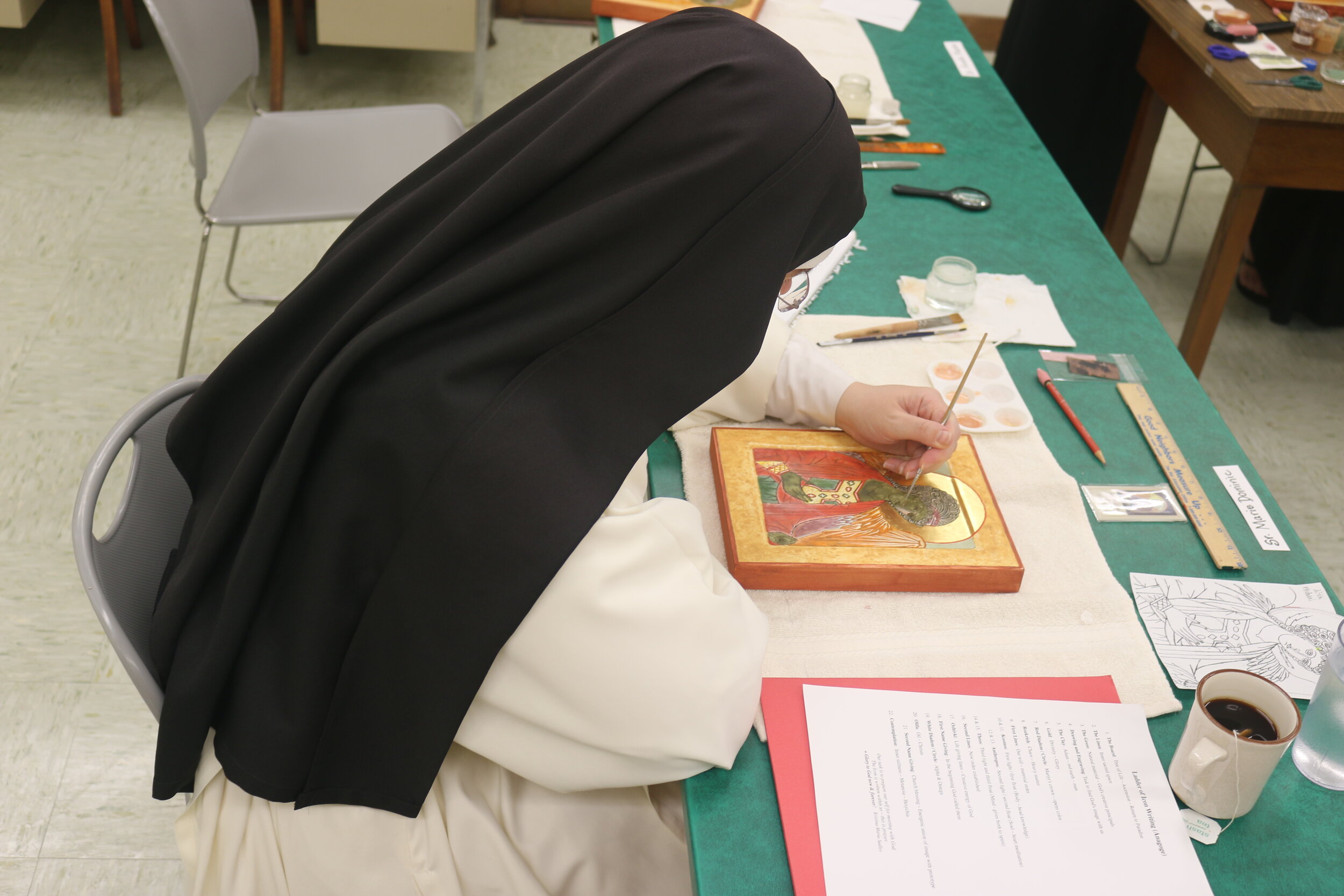

War, Peace, and the Rosary
Every morning when a Dominican dons the habit, he or she is reminded of the fact that he or she is in the middle of a war. The habit hasn’t changed much since it was given to Saint Dominic and the first friars and nuns of the Order of Preachers – white tunic and scapular with a belt, black cappa (and veil for the sisters). But conspicuously attached to the belt where a medieval knight would have slung a sword, is a rosary.
Every morning when a Dominican dons the habit, he or she is reminded of the fact that he or she is in the middle of a war. The habit hasn’t changed much since it was given to Saint Dominic and the first friars and nuns of the Order of Preachers – white tunic and scapular with a belt, black cappa (and veil for the sisters). But conspicuously attached to the belt where a medieval knight would have slung a sword is a rosary.
But we should not think that because we have replaced a sword with a rosary that we are exempt from engaging in war and battles. The real war is all around us and the battleground is our hearts and souls, as well as the hearts and souls of all those we hold dear. It is the war between good and evil and the stakes are eternal. We experience this war not only in broadscale violence, oppression and injustices, but even on a seemingly much smaller, yet more insidious scale. Every time we choose sin, every time our heart becomes a bit harder or more insensitive to the things of God, as well as every time we choose the good, helping our neighbor, extending a kind or encouraging word to someone in pain, these are blows for one side and against the other. We can perpetuate the evil in the world, or we can be a beacon for good.
Aleksandr Solzhenitsyn describes our situation this way: “If only it were all so simple! If only there were evil people somewhere insidiously committing evil deeds, and it were necessary only to separate them from the rest of us and destroy them. But the line dividing good and evil cuts through the heart of every human being. And who is willing to destroy a piece of his own heart?”
Today it is so easy to take what we see and hear and think “us versus them”, whether it’s in politics or the Church. And, we can also fall into the trap of assuming “our side has the truth!” Yet if we want true peace, truth and goodness to prevail in the world, it must first prevail in our hearts. We must be transformed by the renewal of our minds and our hearts must be made like Jesus.
Besides the Eucharist and the sacraments, we have no more powerful weapon to wield than Our Lady’s Rosary. Dominicans have long been champions of the rosary: it is an incarnational prayer that incorporates the body, the heart and the mind as the beads slip through fingers and the vocal prayers pass through the lips. It is a Marian prayer as it tames the heart to be docile and receptive to God’s word. It is a Christocentric prayer as the mind is illumined and transformed by Truth contained in the mysteries. It has the power to change lives and bring souls to eternal bliss in God. It can be prayed anywhere at almost any time. In times of grief, we can offer the sorrowful mysteries and join our pain with those of Jesus and Mary. The joyful mysteries show us what should really make us happy, what we should desire and strive for. And the glorious mysteries give us hope and courage to persevere to the end. We have no choice about whether we will be involved in this war. There is no neutral zone.
The Rosary is a powerful weapon in our daily spiritual battle. If we want peace in our world, in our country, in our communities, in our families, in our hearts, we must take up the weapons God has provided for us, stand firm and fight. And the battle begins and ends within each one of us.
Our Lady of the Rosary, pray for us!
May They Rest in Peace: Anniversary of Deceased Friends and Benefactors of the Order of Preachers
Gratitude towards benefactors is a natural virtue, but the grace of Christianity perfects its interior principle and makes its effects more lasting. When our friends, employees and benefactors have passed into eternal life, gratitude follows them beyond the tomb and assists them by numerous prayers.
Gratitude towards benefactors is a natural virtue, but the grace of Christianity perfects its interior principle and makes its effects more lasting. When our friends, employees and benefactors have passed into eternal life, gratitude follows them beyond the tomb and assists them by numerous prayers. Every day before meals the “De Profundis” [Psalm 130] is recited for them, as if we dared not take our bread before recommending to God those to whom, perhaps, we owe it.
Today, we commemorate our departed friends and benefactors by a solemn anniversary. Let each one, therefore, be mindful of it, and thus merit the increased protection of the saints for the work to which we have devoted our life. This devotion was remarkable in the Ven. Sister Magdalene de Lorca who, while visiting the different altars of the convent church (a devotion very dear to St. Dominic), saw the souls of the departed anxiously following her from one altar to another until she had finished her prayers.
Prayer: My God, grant to the faithful departed friends and benefactors of the Order a place of refreshment, light and peace.
Practice: Before meals, say three Ave Marias for the deceased who have done you good, either spiritual or temporal, either in the world or in religion.
From “Saints and Saintly Dominicans: Daily Reflections on Their Lives”, edited by Rev. Thomas a Kempis Reilly, O.P. (1915).
Eight Ways We Go Astray
On the road to God and eternal happiness, there are eight common pitfalls that can trap us and keep us captive. Here’s what they are and how to avoid them.
From the earliest days of Christianity, men and women have gone out into the desert, seeking God and to “bear fruit worthy of repentance.” These Desert Fathers and Mothers are at the foundations of monastic life, and their wisdom and teachings were passed down from one monk and nun to the next. But one man systematized them into some very practical advice for those seeking God. Evagrius described for us “Eight Evil Thoughts” and stated that all our thoughts can be classified into one of these eight. And these thoughts, if left unchecked, keep us from true prayer, lead us away from God and take us down paths were we “do what we don’t want to do and don’t do what we want.” Evagrius and the Desert Fathers knew that the first step to real transformation is to know ourselves – our own thoughts and desires – and only then can we avoid the insanity of doing the same thing again and again, yet expecting different results.
These Eight Thoughts were picked up, further developed and refined by John Cassian, Saint Gregory the Great, Saint Thomas Aquinas and others to become the Capital (or Deadly) Sins many of us are familiar with today. So here’s a quick rundown of the Evagrius’ “Eight” and how to fight them.
Finally, some general remedies:
Suffer from a wandering mind? Regain focus by reading Scripture and spiritual books, spending time at night or in the early morning in silent waiting on God, and pray.
Ablaze with “flames of desire”? Quench earthly desires with fasting, regular manual labor (and/or exercise), and solitude.
Afflicted with irascibility (anger)? Calm the beast within by singing psalms (for example, the Divine Office), practicing patience, and almsgiving or works of mercy.
Of course, we can’t fight any of these without God’s help and grace, so we should always ask Him for it!
Go to Joseph!
This is the advice given by many saints, and Dominicans are no exception.
This is the advice given by many saints, and Dominicans are no exception. The Dominicans began invoking Saint Joseph in the Litany of the Saints before he was added to the Litany according to the Roman. The sixty-third Master of the Order, Father Jandel, often recommended to the friars devotion to Saint Joseph.
Saint Joseph assists the young Dominican novice to imitate the simplicity and docility of the Infant Jesus. For those who are devoted to the Holy Rosary, he obtains knowledge and love of the mysteries of Mary. Those engaged in work, labor with more courage under the eye and by the example of Saint Joseph. Those engaged in study can better sanctify in his sweet company the hours spent; the apostle, called to go into the world, carries there the same blessings which the Holy Family, with Saint Joseph for guide, carried into Egypt. The dying sanctify under this holy patronage their last hours, and obtain a more peaceful end and after death received more abundant prayers.
It was in order to obtain these more fervent suffrages that the holy brother Joseph de Rueda every night when the bell rang for the prayers for the dead, went and sprinkled the graves with holy water, and then the cells of the prior and the brethren, in the hope that all would recite more devoutly the prayers for the dead. And in our community, one of our devotions to Saint Joseph is to pray his memorare each evening after Supper.
Saint Joseph, pray for us!
Based on an excerpt from Saints and Saintly Dominicans, edited by Rev. Thomas a Kempis Reilly, O.P. (John Murphy Company, 1915).
The Gift of the Fourth Wise Man
How many Magi visited the Holy Family? We don’t actually know, because Scripture doesn’t specify exactly. Tradition tells us there were three because Scripture mentions three gifts they brought: gold, frankincense and myrrh. But legend speaks of a fourth. Here is his story.
How many Magi visited the Holy Family? We don’t actually know, because Scripture doesn’t specify exactly. Tradition tells us there were three because Scripture mentions three gifts they brought: gold, frankincense and myrrh. But legend speaks of a fourth. Here is his story.
Far to the east of the sea, lived a small group of men known to be wise. They had studied the teachings of their forebears and watched the signs of nature, intuiting hidden secrets discovered only by those patient and watchful enough to see them. But no matter how much they learned, they still thirsted for more. It was as if true wisdom was still veiled, hidden, from their sight. They felt they were closest to this eternal wisdom at night when they could watch the stars. When the world was covered in silent darkness, the stars seemed to be pinpricks in the fabric of creation, letting through the true light of wisdom.
Four of these men were assembled together one night, as was their custom, on the roof of a house. Suddenly, something caught their attention - a star, brighter than the rest. But not just any star, they knew in their hearts. THE STAR. Someone very great, a king, had risen in the world, and they felt compelled to follow it and do him homage. So they prepared for the long, arduous journey, not knowing exactly where they would end up or how long it would take. Along with all their provisions, they packed gifts fit for a king, priceless treasures. And off they went.
But as they traveled, they met poor and desperate people along the way. And the fourth wise man’s heart was moved with deep compassion for them, and he began to give away his treasures and possessions. His friends smiled and shook their heads, and his heart was lightened at the joy in the faces of those whose suffering he was able to relieve.
Then, the star stopped! They had arrived! As his friends unpacked their gifts, the fourth wise man was grief-stricken and sorrowful - he had given everything away! His treasures, all his provisions, he had nothing to present to this great king! This was an immense sign of disrespect in his culture, but he simply could not turn back now. His heart held a great yearning to see this new king. And so, with head lowered and heart heavy, he followed his friends into the little house. Each of the first three presented their gifts and did him homage: gold, frankincense and myrrh. Kingly and priestly gifts indeed. The room was still as everyone turned to the fourth Magi. He could not bear to raise his head but simply stepped forward and held out his arms to show their emptiness. Tears welled up and began to stream down his cheeks as he stumbled over the words to explain.
But before he could say anything, his empty arms were suddenly weighed down with a soft, sturdy bundle. He blinked away the tears and the face of a tiny baby, nestled in blankets, came into focus. And as he looked deep into the infant eyes looking up at him intently, he saw the light of the stars.
How We Spent Our Summer Vacation, Part 5: The Labor Day Week Finale!
Each year around Labor Day, we have the privilege and joy of extending hospitality to one of our Dominican friars, Father Luke Buckles, O.P., before he returns to the Pontifical University of Saint Thomas Aquinas (the Angelicum) in Rome, where he is a professor of theology. This year, as part of his visit, we were treated to a two-session seminar on Dominican and Carmelite mystics.
Each year around Labor Day, we have the privilege and joy of extending hospitality to one of our Dominican friars, Father Luke Buckles, O.P., before he returns to the Pontifical University of Saint Thomas Aquinas (the Angelicum) in Rome, where he is a professor of theology. This year, as part of his visit, we were treated to a two-session seminar on Dominican and Carmelite mystics. Father wove together insights from St. Catherine of Siena, St. Thomas Aquinas, St. Therese of Lisieux, St. Teresa of Avila, and St. John of the Cross. One common thread that emerged was the unity of life bestowed by grace in the lives of the mystics. Each of these Doctors of the Church experienced a profound sense of God’s presence at every moment and in every circumstance, whether sacred or mundane.
While we make think that mysticism is too lofty for everyday life, Father reminded us of a few lessons from these great saints: St. Teresa of Avila taught her sisters that prayer is never interrupted by charity. If one is called out of choir to help a sister in need, there is no break in one’s prayerful union with the Lord. St. Therese of Lisieux found heaven in doing little, mundane tasks, such as picking up a pen from the floor, with great love for God and neighbor. St. Catherine of Siena is famous for her discovery of the “interior cell,” in which she constantly dwelt with God even in the midst of a crowd.
And to quote another Dominican, Meister Eckhart, we are challenged: “Don’t go around doing holy things. Make everything you do holy!”
How We Spent Our Summer Vacation! Part One: A Prophet-able Retreat
September already?! For most that means school is back in full swing, complete with extra-curricular activities, and a busy work schedule. And for many students, that first assignment is to write a report, or share with the class "How I Spent My Summer Vacation."
September already?! For most that means school is back in full swing, complete with extra-curricular activities, and a busy work schedule. And for many students, that first assignment is to write a report, or share with the class "How I Spent My Summer Vacation."
As for our community, our last blog post was published at the end of July (yikes!) and entitled, "Into the Desert!" as we began our annual retreat. Some of you may have begun to wonder whether we got lost there! So, here is the first of our report, "How Nuns Spend a Summer Vacation."
A Prophet-able Retreat
We had our annual retreat from July 26 to August 2 with Fr. Michael Carey, O.P. as our retreat master. He gave us thought-provoking homilies and morning reflections from the daily Mass readings, which focused on the prophet Jeremiah; in the afternoon, his reflections were on the life of Moses, whose relationship with God stands out as a model of the Christian life.
Thank you for your prayers for our community, particularly during our retreat. We came out of it renewed and refreshed, with new insights to continue our own journey and adventure with the Lord.











